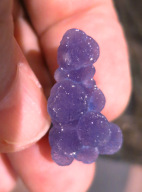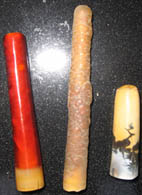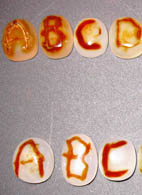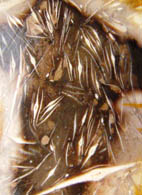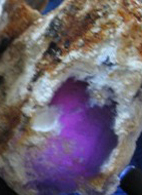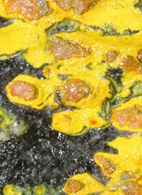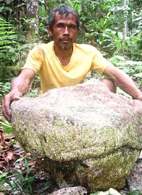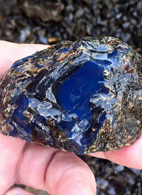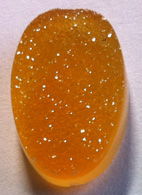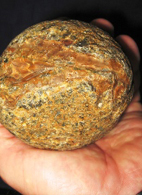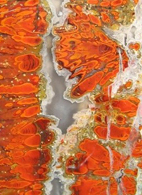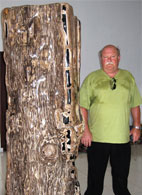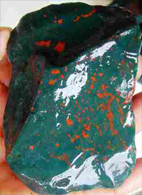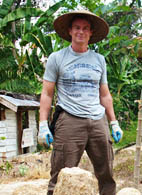The country of Indonesia is situated in SE Asia. The capital, Jakarta, in West Java, lies on the western end of the island of Java nestled amongst composite volcanoes. Indonesia consists of 17,508 islands which extend over 5,120 kilometers from east to west. The country lies in a highly active tectonic belt. The tallest mountains reach 4,884 meters and nearby ocean trenches reach depths of 4,440 meters.

Some of these islands have experienced millions of years of intermittent volcanic activity as a result of the spreading Indian Ocean floor sinking beneath the islands and melting as it becomes heated at depth. In fact there are 129 active volcanoes in Indonesia today, accounting for 13% of the active volcanoes in the world.
With each volcanic eruption, millions of tons of volcanic ash are blown into the sky. This material rains down upon the land, burying the forests, filling lakes and choking rivers. Some large eruptions can deposit layers of volcanic ash locally up to hundreds of meters thick. Ash deposits can cover hundreds if not thousands of square kilometers.

Around the World, petrified woods can be found in both volcanic and sedimentary rock formations. Typically the woods are preserved by burial in volcanic debris but after it becomes petrified, it can be eroded from the volcanic strata and re-deposited in sedimentary formations, such as sandstone, siltstone or shale.
The volcanic rock formations in which preservation of woods occur, are usually high silica (SiO2) content volcanic tuffs and breccias from violent explosive eruptions. The classification of these rocks range from dacite to rhyolite. Some silica rich tuffs mature into colorful jaspers.



The preservation of these ancient forests occurs thru processes of infill and replacement of the organic components of the woods with minerals deposited by hot waters trapped within the rock formations. The pores of the woods are filled and the fibers are replaced cell by cell with a variety of minerals dominantly composed of silica (SiO2) and carbonate (CaO3). Various colorations imparted to the woods during preservation are from iron, manganese, copper and other dissolved metals.


Red, green and purple colors are usually from iron minerals. Manganese often creates pink, black and brown coloration and copper minerals can produce blue and green.


The ancient processes which preserved woods and formed fossils are no different than the processes acting on modern forests when a volcanic erupts today. The difference we see is only that which results over time.
Initially the silica (Si02) is dissolved from the decaying volcanic ash during exposure to oxygenated surface waters that descend and mix with the loose deposits of volcanic ash. The groundwater becomes acidic and dissolves silica and other minerals released from the ash. This dissolved silica in the form of silicic acid, attaches itself to the lignin and cellulose of the wood.
Colors of rich orange, red and purples resulted from the iron, manganese and other elements in the mix.

As the deposit becomes buried deeper, increasing heat and pressure causes further dehydration and converts the silica gel to opal. Opal is the amorphous, non crystaline form of quartz, which forms at the lowest of temperatures and pressures.
Over a period of millions of years, under increasing temperatures and pressures, the opal further dehydrates and re-crystallizes into microcrystalline quartz (chalcedony) commonly known as agate. In some situations higher temperature quartz crystallizes up to centimeters in size.


Various factors result in the preservation of the relict woody texture. Important are the assorted mineral components of the saturated solutions during pore space filling and subsequent mineral reactions and replacements. These components impart contrast defining the relict textures suggestive of original internal ring and cell structures of the now silicified trees.


In the rock formation, each piece of wood becomes silicified within its own local geochemical environment, the trace elements and minerals contained will vary greatly from piece to piece resulting in variations in preservation even in pieces found only meters apart. The result makes each and every piece of petrified wood unique and one of a kind.
Petrified woods across Indonesia have been forming for many million years and can be found in many rock formations from the far west in Sumatra to the far east in Timor and Irian Jaya. Very little study of these ancient forests has been done. New species of fossil palm and fossil wood are waiting to be found.





